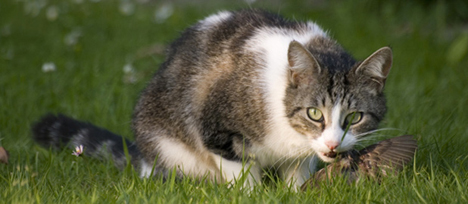
Feral cats are one of the top carriers of rabies
By Stan Kirkland, FWC
It’s fair to say Americans love their house cats. Although no one knows how many house cats Americans own, it’s in the millions.
However, the practice by some of releasing unwanted cats outdoors under a trap-neuter-
release (TNR) program is under increased scrutiny as some communities and businesses have banned the practice.
Cat advocacy groups say in theory feral cats that are spayed or neutered and let go in TNR areas can’t reproduce and the colonies will die out over time. They say this is a better alternative to euthanasia of unwanted cats.
What the advocacy groups don’t say is feral cats are one of the top carriers of rabies, according to the Centers of Disease Control and Prevention. Unvaccinated feral cats can pass the highly contagious disease from cat to cat, and maybe a link in the transmission of rabies to wildlife such as fox and raccoons.
Feral cats can also transmit feline leukemia to house pets and other feral cats and carry the
feline panleucopenia virus. The disease has been passed to bobcats and even to endangered panthers in south Florida, according to the Florida Fish and Wildlife Conservation Commission (FWC).
Wildlife advocates say feral cats, as well as house cats allowed to run loose, prey on native birds, small mammals and even some reptiles. The American Bird Conservancy, one of the largest bird conservation groups in the United States, has repeatedly called for responsible pet ownership and opposes TNR programs that promote feral cat colonies. The group says millions of song birds and other wildlife are killed by outdoor cats every year.
In 2003 the FWC agreed that feral cats pose a serious threat to native birds and other wildlife. The agency adopted a policy for feral cats on state lands, which called for education about the issues, community outreach to discourage the feeding and maintenance of feral cat colonies, and partnerships with animal shelters.
Cat rescue groups say there’s a lack of hard evidence to support the claims of wildlife losses due to feral and free-roaming cats. Instead, they point to construction and development and the loss of wildlife habitat, pollution and even predation by other wildlife as the culprits.
A study published in the respected Journal of Wildlife Management in 2008 adds another
element to the discussion – those who allow cats to roam free may be inviting disaster on their pets. Researchers monitored the movements of eight radio-collared coyotes for three months on the outskirts of Tuscon, Ariz., and of 36 coyote-cat interactions, 19 resulted in coyotes killing the cats.
Almost everyone agrees that responsible pet ownership is the key. On the subject of feral cats, there is little agreement on solutions.
To learn more go to: American Bird Conservancy
